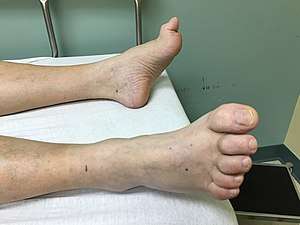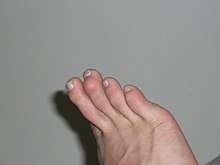Hammer toe
A hammer toe or contracted toe is a deformity of the muscles and ligaments of the proximal interphalangeal joint of the second, third, or fourth toe causing it to be bent, resembling a hammer. In the early stage a flexible hammertoe is movable at the joints; a rigid hammertoe joint cannot be moved and usually requires surgery.[1]
| Hammer toe | |
|---|---|
| Other names | Contracted toe |
 | |
| Human feet with hammer toes | |
| Specialty | Podiatry |
Mallet toe is a similar condition affecting the distal interphalangeal joint.[2]
Claw toe is another similar condition, with dorsiflexion of the proximal phalanx on the lesser metatarsophalangeal joint, combined with flexion of both the proximal and distal interphalangeal joints. Claw toe can affect the second, third, fourth, or fifth toes.
Causes

Hammertoes and clawtoes have multiple causes.[3] [4] Hammer toe most frequently results from wearing poorly fitting shoes that can force the toe into a bent position, such as excessively high heels or shoes that are too short or narrow for the foot. Having the toes bent for long periods of time can cause the muscles in them to shorten, resulting in the hammer toe deformity. This is often found in conjunction with bunions or other foot problems (e.g., a bunion can force the big toe to turn inward and push the other toes). It can also be caused by muscle, nerve, or joint damage resulting from conditions such as osteoarthritis, rheumatoid arthritis, stroke, Charcot–Marie–Tooth disease, complex regional pain syndrome or diabetes.[5] Hammer toe can also be found in Friedreich's ataxia (GAA trinucleotide repeat).

Treatment
In many cases, conservative treatment consisting of physical therapy and new shoes with soft, spacious toe boxes is enough to resolve the condition, while in more severe or longstanding cases hammertoe surgery[6] may be necessary to correct the deformity. The patient's doctor may also prescribe some toe exercises that can be done at home to stretch and strengthen the muscles. For example, the individual can gently stretch the toes manually, or use the toes to pick things up off the floor. While watching television or reading, one can put a towel flat under the feet and use the toes to crumple it. The doctor can also prescribe a brace that pushes down on the toes to force them to stretch out their muscles.
References
- Sabrina Felson. "Understanding Hammertoes -- the Basics". WebMD. Reviewed March 31, 2019
- Mayo Clinic, "Hammertoe and mallet toe"
- Chadwick, C; Saxby, TS (December 2011). "Hammertoes/Clawtoes: metatarsophalangeal joint correction". Foot and Ankle Clinics. 16 (4): 559–71. doi:10.1016/j.fcl.2011.08.006. PMID 22118229.
- Ellington, JK (December 2011). "Hammertoes and clawtoes: proximal interphalangeal joint correction". Foot and Ankle Clinics. 16 (4): 547–58. doi:10.1016/j.fcl.2011.08.010. PMID 22118228.
- "Hammer toe and mallet toe – causes". Mayo Clinic. Retrieved 2009-01-30.
- Benefits and Risks of Hammertoe Surgery
External links
- Hammer Toe – American Academy of Orthopedic Surgeons
- Hammer Toes – American Podiatric Medical Association
- Aetna Clinical Policy Bulletin: Hammertoe Repair Guidelines for surgical repair
| Classification | |
|---|---|
| External resources |